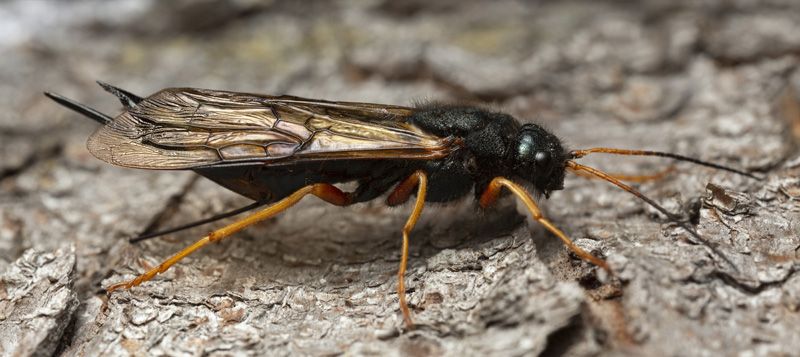
Sirex Woodwasp – Sirex noctilio
Sirex Woodwasp – Sirex noctilio
Description of Insect:
The Sirex Woodwasp (Sirex noctilio) is an invasive wood-boring insect that primarily targets pine trees. Native to Europe, Asia, and North Africa, it has spread to the Southern Hemisphere, northeastern, and midwestern US, and southeastern Canada. It does not sting and is more closely related to horntails, a group of wood-boring insects.
Adult Sirex Woodwasps are large, measuring between 2.5 to 4 cm in length. They have black, elongated, cylindrical bodies with dark metallic blue or green coloration. Females can be distinguished by a long, spear-like ovipositor on the tail-end, used to deposit eggs deep inside tree trunks. Their larvae are white with a characteristic dark spine at the abdominal end.
These woodwasps have a unique relationship with a symbiotic fungus, Amylostereum areolatum, which they inject into trees along with their eggs. The fungus weakens the tree by disrupting the vascular system, and the developing larvae feed on it.
Life cycle of Sirex Woodwasp:
The lifecycle of the Sirex Woodwasp begins when a female selects a stressed or weakened pine tree to lay her eggs. Using her ovipositor, she drills into the tree’s outer bark and deposits 1-3 eggs, along with toxic mucus and fungal spores. The mucus dries the tree’s tissues, while the fungus spreads through the wood, disrupting the vascular system.
Once the eggs hatch, the larvae burrow deeper into the wood, feeding on the fungus. When the larvae are fully developed, they pupate for 3 weeks within the wood before emerging through round exit holes.
The adult stage is short-lived, lasting only a few days to a couple of weeks. During this time, they focus solely on reproduction. Since adult wasps do not feed, they rely on stored energy reserves accumulated during their larval stage. Once the mating process is complete, females seek out new host trees to continue the cycle.
Damage they cause:
Sirex Woodwasps pose a significant threat to pine forests. Their infestations weaken trees, disrupt forest ecosystems, and reduce the value of timber.
- Ecological Damage:Sirex noctilio usually infests stressed pines; however, an increased population of wasps may also damage healthy trees, leading to rapid tree decline. The fungal infection spreads through the tree, interfering with water and nutrient transport, ultimately killing the tree from the inside.
- Economic Impact:Infested trees suffer from extensive internal decay due to fungal growth, making their wood unsuitable for lumber and other commercial uses. This results in economic losses for timber industries that rely on high-quality pine wood. According to the United States Department of Agriculture Forest Service, the nationwide spread of Sirex Woodwasp may potentially cost $2.8-$17 billion in lost timber and pulpwood.
- Reduced Aesthetic:The damage caused by Sirex Woodwasp infestations leaves behind dead and dying trees, diminishing the visual appeal of forests and natural landscapes. Discolored, wilting, or fallen trees disrupt the scenic beauty of parks and woodlands, reducing their recreational and economic value.
